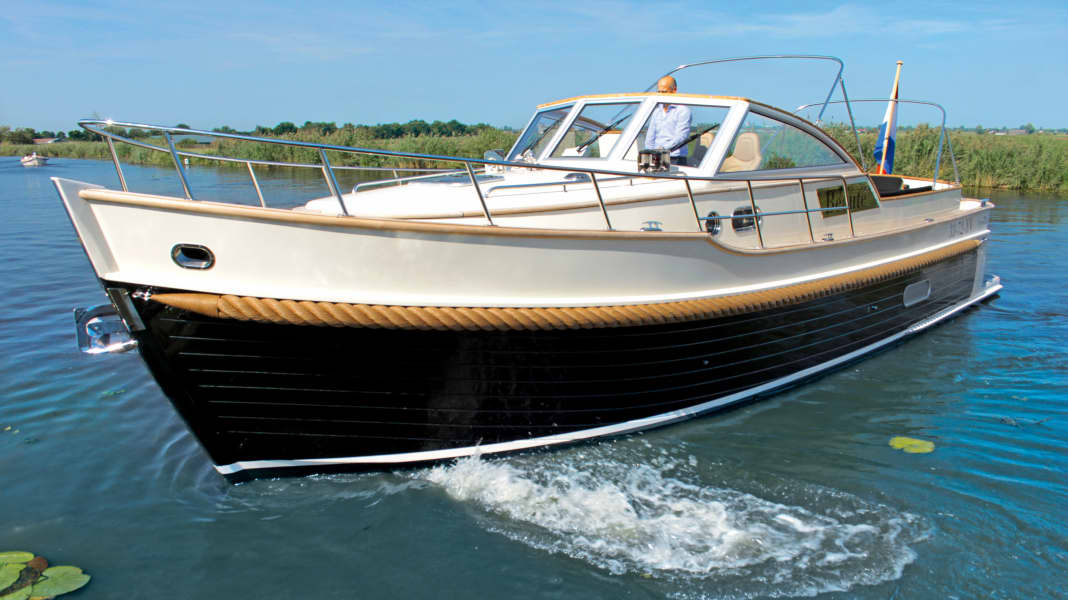
The motor yacht glides almost silently into the harbour. Silence reigns until just before the box, then the bow propeller begins to rattle and the silence is over, as the cavitation on the propeller in the narrow tunnel causes some noise.
The helmsman expects something similar when using the mooring aid on board the test vessel, a Newport Bass made of GRP. But not a chance. A pump is audible, albeit only quietly, as it is housed in the well-insulated engine compartment. A little splashing, that's it. The water sports enthusiast doesn't hear any more noise. The Jetthruster, which is installed in the nine-metre-long and approximately five-tonne vessel, is able to generate a lot of pressure.
It turns the boat on the disc without any problems, even against the wind, which was a little gusty on the test day. As with an ordinary bow thruster, the first moment you feel like you're being swept off your feet.
Even when the bow and stern thrusters are working at the same time, the ship rotates properly - but with half the power per outlet due to the design, as only one pump is installed and the two outlets have to share the power. "Of course, we can also install two pumps if required, in which case the problem doesn't exist," explains Pieter Cats. He is Managing Director at Holland Marine Parts, the manufacturer of the Jetthruster.
This does not seem necessary, as the boat follows the instructions of the joysticks for several minutes. The electric motor then requires a cool-down phase, just as is the case with conventional bow thrusters. A disadvantage of the installation on the test boat was the installation location in the warm engine compartment. Installed in a cool compartment below the waterline, the unavoidable heating is certainly slower and the operating time increases.
Nevertheless, the system works. It is particularly suitable for ships up to around 12 metres in length. Pieter Cats: "That is the strength of the Jetthruster: the required installation space is small.
The components can also be flexibly distributed in the boat. And thanks to the comparatively small openings that the nozzles require at the bow, they can be positioned very far forward." According to the expert, this makes sense because of the longer lever arm in front of the boat's centre of rotation.
This almost compensates for the lower efficiency of a pump compared to a propeller in the water (as with a bow thruster). Nevertheless, the motor that drives the pump has a full 3000 watts of power even in the smallest system. A bow thruster with the same thrust requires a drive that is exactly half the size.
This raises the question of price: Without installation, the smallest complete Jetthruster system, the JT 30, costs around 4000 euros. A classic bow thruster with the same thrust and all components is available for around half the price. However, the installation costs for this are higher, as the tube has to be laminated or welded in, whereas the Jetthruster only requires a few onboard outlets including electrical installation.
The price difference is further relativised if the same pump is used to supply bow and stern thrusters. This is because the only additional costs incurred are for the additional three-way valve, hoses and on-board outlets. The pump is simply used for both. Conventional systems, on the other hand, involve a complete double installation with double the costs.
But price is not always the deciding factor: "For many boats, the small nozzle diameter and the fact that the outlets only need to be installed around seven centimetres below the waterline mean that we are the only way to install a mooring aid that makes any sense at all. We sell many systems for cabin cruisers, for example, where the forefoot is flat and often only starts a long way aft of the bow," explains Cats. "A bow thruster would have to be installed so far aft because of the tube diameter that it would no longer make sense to install a system at all."
The situation is no different at the stern. One or more Z-drives, alternatively shafts and rudders, trim tabs, bathing platform: the space to accommodate a tunnel for a thruster is limited. "Then our thrusters are often the only option. They can be installed either on the side or concealed on the transom, in the 90-degree version. This also allows the stern to be directed precisely," says Cats.
Incidentally, the Jetthruster is less intended for large steel displacers: "They all already have a tunnel, and space is usually not a problem."
However, anyone who owns a (semi-)glider and would like to have an invisible and barely audible hand to help with docking manoeuvres should take a closer look at the Jetthruster. It is not without reason that series shipyards such as Mastercraft, Outerlimits or Long Island now also rely on the system, which means larger quantities and therefore a reliable supply of spare parts.

